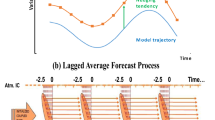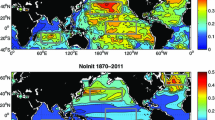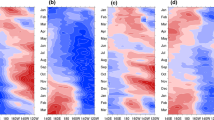Abstract
The overall skill of ENSO prediction in retrospective forecasts made with ten different coupled GCMs is investigated. The coupled GCM datasets of the APCC/CliPAS and DEMETER projects are used for four seasons in the common 22 years from 1980 to 2001. As a baseline, a dynamic-statistical SST forecast and persistence are compared. Our study focuses on the tropical Pacific SST, especially by analyzing the NINO34 index. In coupled models, the accuracy of the simulated variability is related to the accuracy of the simulated mean state. Almost all models have problems in simulating the mean and mean annual cycle of SST, in spite of the positive influence of realistic initial conditions. As a result, the simulation of the interannual SST variability is also far from perfect in most coupled models. With increasing lead time, this discrepancy gets worse. As one measure of forecast skill, the tier-1 multi-model ensemble (MME) forecasts of NINO3.4 SST have an anomaly correlation coefficient of 0.86 at the month 6. This is higher than that of any individual model as well as both forecasts based on persistence and those made with the dynamic-statistical model. The forecast skill of individual models and the MME depends strongly on season, ENSO phase, and ENSO intensity. A stronger El Niño is better predicted. The growth phases of both the warm and cold events are better predicted than the corresponding decaying phases. ENSO-neutral periods are far worse predicted than warm or cold events. The skill of forecasts that start in February or May drops faster than that of forecasts that start in August or November. This behavior, often termed the spring predictability barrier, is in part because predictions starting from February or May contain more events in the decaying phase of ENSO.











Similar content being viewed by others
References
AchutaRao K, Sperber KR (2002) Simulation of the El Niño-Southern Oscillation: results from the coupled model intercomparison project. Clim Dyn 19:191–209
AchutaRao K, Sperber KR (2006) ENSO Simulation in coupled ocean–atmosphere models: are the current models better? Clim Dyn 27:1–15
An SI, Wang B (2001) Mechanisms of locking the El Nino and La Nina mature phases to boreal winter. J Clim 14:2164–2176
Balmaseda MA, Davey MK, Anderson DLT (1995) Decadal and seasonal dependence of ENSO prediction skill. J Clim 8:2705–2715
Barnett TP, Graham NE, Cane MA, Zebiak SE, Dolan SC, O’Brien J, Legler D (1988) On the prediction of the El Niño of 1986–1987. Science 241:192–196
Barnston AG, Glantz M, He Y (1999) Predictive skill of statistical and dynamical climate models in SST forecasts during the 1997–98 El Niño and the 1998 La Niña onset. Bull Amer Met Soc 80:217–243
Barnston AG, van den Dool HM, Zebiak SE, Barnett TP, Ji M, Rodenhuis DR, Cane MA, Leetmaa A, Graham NE, Ropelewski CR, Kousky VE, O’Lenic EA, Livezey RE (1994) Long-lead seasonal forecasts—Where do we stand? Bull Am Met Soc 75:2097–2114
Barnston AG, Chelliah M, Goldenberg SB (1997) Documentation of a highly ENSO-related SST region in the equatorial Pacific. Atmos–Ocean 35:367–383
Battisti DS, Hirst AC (1989) Interannual variability in the tropical atmosphere–ocean system: influence of the basic stated, ocean geometry, and non-linearity. J Atmos Sci 46:1687–1712
Battisti DS (1988) Dynamics and thermodynamics of a warming event in a coupled tropical atmosphere–ocean model. J Atm Sci 45:2889–2919
Bengtsson L, Schlese U, Roeckner E, Latif M, Barnett TP, Graham NE (1993) A two-tiered approach to long-range climate forecasting. Science 261:1027–1029
Blumenthal MB (1991) Predictability of a coupled ocean–atmosphere model. J Clim 4:766–784
Bradley RS, Diaz HF, Kiladis GN, Eishcheid JK (1987) ENSO signal in continental temperature and precipitation records. Nature 327:497–501
Cane MA, Zebiak SE, Dolan SC (1986) Experimental forecasts of El Niño. Nature 321:827–832
Chen D, Zeiak SE, Busalacchi AJ, Cane MA (1995) An improved procedure for El Niño forecasting: implications for predictability. Science 269:1699–1702
Clarke AJ, Van Gorder S (1999) The correlation between the boreal spring Southern Oscillation persistence barrier and biennial variability. J Clim 12:610–620
Davey M, Huddleston M, Sperber KR, Braconnot P, Bryan F, Chen D, Colman RA, Cooper C, Cubasch U, Delecluse P, DeWitt D, Fairhead L, Flato G, Gordon C, Hogan T, Ji M, Kimoto M, Kitoh A, Knutson TR, Latif M, Le Treut H, Li T, Manabe S, Mechoso CR, Meehl GA, Oberhuber J, Power SB, Roeckner E, Terray L, Vintzileos A, Voss R, Wang B, Washington WM, Yoshikawa I, Yu JY, Yukimoto S, Zebiak SE (2002) A study of coupled model climatology and variability in tropical ocean regions. Clim Dyn 18:403–420
Delecluse P, Davey M, Kitamura Y, Philander S, Suarez M, Bengtsson L (1998) TOGA review paper: coupled general circulation modeling of the tropical Pacific. J Geophys Res 103:14357–14373
Delecluse P, Madec G (1999) Ocean modeling and the role of the ocean in the climate system. In: Holland WR, Joussaume S, David F (eds) Modeling the earth’s climate and its variability. Elsevier, Amsterdam, pp 237–313
Deque M (2001) Seasonal predictability of tropical rainfall: Probabilistic formulation and validation. Tellus 53A:500–512
Fischer M (2002) ENSO predictions with coupled ocean–atmosphere models. In: Pinardi N, Woods J (eds) Ocean forecasting. Springer, Berlin, pp 307–338
Fu X, Wang B, Li T, McCreary J (2004) Coupling between northward-propagating, intraseasonal oscillations and sea surface temperature in the Indian Ocean. J Atmos Sci 60:1733–1753
Goddard L, Mason SJ, Zebiak SE, Ropelewski CF, Basher R, Cane MA (2001) Current approaches to seasonal-to-interannual climate predictions. Int J Climatol 21:1111–1152
Gordon C, Cooper C, Senior CA, Banks H, Gregory JM, Johns TC, Mitchell JFB, Wood RA (2000) The simulation of SST, sea ice extents and ocean heat transports in a version of the Hadley Centre coupled model without flux adjustments. Clim Dyn 16:147–168
Goswami BN, Shukla J (1991) Predictability of the coupled ocean–atmosphere model. J Clim 4:3–22
Graham NE, Michaelson J, Barnett TP (1987) An investigation of the El Niño-Southern Oscillation cycle with statistical models: II. Model results. J Geophys Res 92:14271–14289
Gregory D, Morcrette JJ, Jakob C, Beljaars ACM, Stockdale T (2000) Revision of convection, radiation and cloud schemes in the ECMWF Integrated Forecasting System. Q J R Meteor Soc 126:1685–1710
Gualdi S, Alessandri A, Navarra A (2005) Impact of atmospheric horizontal resolution on El Niño Southern Oscillation forecasts. Tellus 57A:357–374
Ji M, Behringer DW, Leetmaa A (1998) An improved coupled model for ENSO prediction and implications for ocean initialization. Part II: The coupled model. Mon Weather Rev 126:1022–1034
Ji M, Leetmaa A (1997) Impact of data assimilation on ocean initialization and El Niño prediction. Mon Weather Rev 125:742–753
Jin EK, Kinter JL III (2007) Characteristics of tropical pacific SST predictability in coupled GCM forecasts using the NCEP CFS. J Clim (Submitted)
Jochum M, Murtugudde R (2004) Internal variability of the tropical pacific ocean. Geophys Res Lett 31:L14309. doi:10.1029/2004GL020488
Kanamitsu M, Kumar A, Juang HM, Schemm JK, Wang W, Yang F, Hong SY, Peng P, Chen W, Moorthi S, Ji M (2002) NCEP dynamical seasonal forecast system 2000. Bull Amer Met Soc 83:1019–1037
Kirtman BP (2003) The COLA anomaly coupled model: ensemble ENSOprediction. Mon Weather Rev 131:2324–2341
Kirtman BP, Shukla J, Balmaseda M, Graham N, Penland C, Xue Y, Zebiak SE (2001) Current status of ENSO forecast skill: A report to the Climate Variability and Predictability (CLIVAR) Working Group on Seasonal to Interannual Prediction. WCRP Informal Report No 23/01, 31pp
Kirtman BP, Shukla J, Huang B, Zhu Z, Schneider EK (1997) Multi-seasonal prediction with a coupled tropical ocean global atmosphere system. Mon Weather Rev 125:89–808
Krishnamurti TN, Kishitawal CM, Zhang Z, Larow T, Bachiochi D, Williford E (2000) Multimodel ensemble forecasts for weather and seasonal climate. J Clim 13:4196–4216
Kug JS, Kang IS, Choi DH (2008) Seasonal climate predictability with tier-one and tier-two prediction Systems. Clim Dyn. doi:10.1007/s00382-007- 0264-7
Kug JS, Lee JY, Kang IS (2007) Global sea surface temperature prediction using a multi-model ensemble. Mon Wea Rev 135:3239–3247
Landsea CW, Knaff JA (2000) How much skill was there in forecasting the very strong 1997–98 El Niño? Bull Amer Met Soc 81:2107–2120
Latif M, Barnett TP, Cane MA, Flu¨gel M, Graham NE, Von Storch H, Xu JS, Zebiak SE (1994) A review of ENSO prediction studies. Clim Dyn 9:167–179
Latif M, Sperber K, Arblaster J, Braconnot P, Chen D, Colman A, Cubasch U, Cooper C, Delecluse P, DeWitt D, Fairhead L, Flato G, Hogan T, Ji M, Kimoto M, Kitoh A, Knutson T, Le Treut H, Li T, Manabe S, Marti O, Mechoso C, Meehl G, Power S, Roeckner E, Sirven J, Terray L, Vintzileos A, Vob R, Wang B, Wasington W, Yoshikawa I, Yu JY, Zebiak SE (2001) ENSIP: the El Niño simulation intercomparison project. Clim Dyn 18:255–276
Lau KM, Waliser DE (2005) Intraseasonal variability in the atmosphere–ocean climate system. Springer, Berlin
Leetmaa A, Ji M (1989) Operational hindcasting of the tropical Pacific. Dyn Atmos Oceans 13:465–490
Luo JJ, Masson S, Behera S, Shingu S, Yamagata T (2005) Seasonal climate predictability in a coupled OAGCM using a different approach for ensemble Forecasts. J Clim 18:4474–4497
Madec G, Delecluse P, Imbard M, Levy C (1997) OPA release 8. Ocean general circulation model reference manual. LODYC Internal Rep., Paris, France, 200pp
Madec G, Delecluse P, Imbard M, Levy C (1998) OPA version 8.1 Ocean general circulation model reference manual. LODYC Tech Rep. 11, Paris, France, 91pp
Marsland SJ, Haak H, Jungclaus JH, Latif M, Roske F (2003) The Max-Plank-Institute global ocean/sea ice model with orthogonal curvilinear coordinates. Ocean Modell 5:91–127
Mason SJ, Goddard L, Graham NE, Yulaeva E, Sun L, Arkin PA (1999) The IRI seasonal climate prediction system and the 1997/98 El Niño event. Bull Amer Met Soc 80:1853–1873
Mechoso CR, Robertson AW, Barth N, Davey MK, Delecluse P, Gent PR, Ineson S, Kirtman BP, Latif M, Le Treut H, Nagai T, Neelin JD, Philander SGH, Polcher J, Schopf PS, Stockdale TN, Suarez MJ, Terray L, Thual O, Tribbia JJ (1995) The seasonal cycle over the tropical Pacific in coupled atmosphere–ocean general-circulation models. Mon Weather Rev 123:2825–2838
Murtugudde R, Beauchamp J, McClain CR, Lewis M, Busalacchi AJ (2002) Effects of penetrative radiation on the upper tropical ocean circulation. J Clim 15:470–486
Neelin JD, Dijkstra HA (1995) Ocean–atmosphere interaction and the tropical climatology. Part I: the dangers of flux correction. J Clim 8:1325–1342
Neelin JD, Latif M, Allaart MAF, Cane MA, Cubasch U, Gates WL, Gent PR, Ghil M, Gordon C, Lau NC, Mechoso CR, Meehl GA, Oberhuber JM, Philander SGH, Schopf PS, Sperber KR, Sterl A, Tokioka T, Tribbia J, Zebiak SE (1992) Tropical air-sea interaction in general circulation models. Clim Dyn 7:73–104
Pacanowski RC (1995) MOM 2.2 manual. NOAA/GFDL
Pacanowski RC, Griffies SM (1998) MOM 3.0 manual. NOAA/GFDL. http://www.gfdl.noaa.gov/_smg/MOM/web/guide_parent/guide_parent.html
Palmer TN, Alessandri A, Andersen U, Cantelaube P, Davey M, Delecluse P, Deque M, Diez E, Doblas-Reyes FJ, Feddersen H, Graham R, Gualdi S, Gueremy JF, Hagedorn R, Hoshen M, Keenlyside N, Latie M, Lazar A, Maisonnave E, Marletto V, Morse AP, Orfila B, Rogel P, Terres JM, Thomson MC (2004) Development of a European multi-model ensemble system for seasonal to interannual prediction (DEMETER). Bull Amer Met Soc 85:853–872
Palmer TN, Brankovic C, Richardson DS (2000) A probability and decision-model analysis of PROBOST seasonal multi-model ensemble integrations. Q J R Meteor Soc 126:2013–2034
Philander SGH (1990) El Niño, La Niña and the Southern Oscillation. Academic Press, San Diego, pp 293
Pope VD, Gallani ML, Rowntree PR, Stratton RA (2000) The impact of new physical parameterizations in the Hadley Centre climate model: HadAM3. Clim Dyn 16:123–146
Rasmusson EM, Carpenter TH (1982) Variations in tropical sea surface temperature and surface wind fields associated with Southern Oscillation/El Niño. Mon Weather Rev 110:354–384
Rayner NA, Parker DE, Horton EB, Folland CK, AlenxanderLV, Rowell DP, Kent EC, Kaplan A (2003) Global analyses of sea surface temperature, sea ice, and night marine air temperature since the late nineteenth century. J Geophys Res 108:4407–4443
Roeckner E (1996) The atmospheric general circulation model ECHAM-4: Model description and simulation of present-day climate. Max-Planck-Institut fur Meteorologie Tech. Rep. 218, Hamburg, Germany, 90pp. Available from Max-Planck Institut fur Meteorologie, Bundesstr. 55, D-20146 Hamburg, Germany
Ropelewski CF, Halpert MS (1987) Global and regional scale precipitation patterns associated with the El Niño/Southern Oscillation. Mon Weather Rev 115:1606–1626
Ropelewski CF, Halpert MS (1989) Precipitation patterns associated with the high index phase of the Southern Oscillation. J Clim 2:268–284
Rosati A, Miyakoda K, Gudgel R (1997) The impact of ocean initial conditions on ENSO forecasting with a coupled model. Mon Weather Rev 125:754–772
Saha S, Nadiga S, Thiaw C, Wang J, Wang W, Zhang Q, van den Dool HM, Pan HL, Moorthi S, Behringer D, Stokes D, White G, Lord S, Ebisuzaki W, Peng P, Xie P (2005) The NCEP Cliamte Forecast System. J Clim 15:3483–3517
Schneider EK, DeWitt DG, Rosati A, Kirtman BP, Ji L, Tribbia JJ (2003) Retrospective ENSO forecasts: sensitivity to atmospheric model and ocean resolution. Mon Weather Rev 131:3038–3060
Schneider EK, Huang B, Zhu Z, DeWitt DG, Kinter III JL, Kirtman BP, Shukla J (1999) Ocean data assimilation, initialization and prediction of ENSO with a coupled GCM. Mon Weather Rev 127:1187–1207
Schopf PS, Suarez MJ (1988) Vacillations in a coupled ocean–atmosphere model. J Atmos Sci 45:549–566
Shukla J (1998) Predictability in the Midst of Chaos: A Scientific Basis for Climate Forecasting. Science 282:728–731
Stern W, Miyakoda K (1995) Feasibility of seasonal forecasts inferred from multiple GCM simulations. J Clim 8:1071–1085
Stockdale TN (1997) Coupled ocean–atmosphere forecasts in the presence of climate drift. J Clim 10:809–818
Stockdale TN, Anderson DLT, Alves JOS, Balmaseda MA (1998) Global seasonal rainfall forecasts using a coupled ocean–atmosphere model. Nature 392:370–373
Torrence C, Webster PJ (1998) The annual cycle of persistence in the El Niño /Southern Oscillation, Q J R Meteor Soc 124:1985–2004
Trenberth KE, Branstator GW, Karoly D, Kumar A, Lau NC, Ropelewski C (1998) Progress during TOGA in understanding and modeling global teleconnections associated with tropical sea surface temperatures. J Geophys Res 103:14291–14324
Troup AJ (1965) The “southern oscillation”. Q J R Meteor Soc 91:490–506
Wang B, Ding QH, Fu XH, Kang IS, Jin K, Shukla J, Doblas-Reyes F (2005) Fundamental challenge in simulation and prediction of summer monsoon rainfall. Geophys Res Lett 32:L15711. doi:10.1029/2005GL022734
Wang B, Lee JY, Kang IS, Shukla J, Kug JS, Kumer A, Schemm J, Luo JJ, Yamagata T, Park CK (2007) How accurately do coupled climate models predict the Asian-Australian Monsoon interannual variability? Clim Dyn (Submitted)
Wang G, Kleeman R, Smith N, Tseitkin F (2002) The BMRC coupled general circulation model ENSO forecast system. Mon Weather Rev 130:975–991
Webster PJ (1995) The annual cycle and the predictability of the tropical coupled ocean–atmosphere system, Meteor Atmos Phys 56:33–55
Webster PJ, Yang S (1992) Monsoon and ENSO: Selectively interactive systems. Q J R Meteor Soc 118:877–925
Wolff JE, Maier-Reimer E, Legutke S (1997) The Hamburg Ocean primitive equation model. Deutsches Klimarechenzentrum Tech. Rep. 13, Hamburg, Germany, 13pp. Available from Model and Data Group c/o Max-Planck Institut fur Meteorologie, Bundesstr. 55, D-20146 Hamburg, Germany
Wright PB (1979) Persistence of rainfall anomalies in the central Pacific. Nature 277:371–374
Xue Y, Cane MA, Zebiak SE, Blumenthal MB (1994) On the prediction of ENSO: a study with a low-order Markov model. Tellus 46A:512–528
Yu JY (2005) Enhancement of ENSO’s persistence barrier by biennial variability in a coupled atmosphere–ocean general circulation model. J Geophys Res 32:L13707. doi:10.1029/2005GL023406
Zebiak SE, Cane MA (1987) A model El Niño-Scouthern Oscillation. Mon Weather Rev 115:2262–2278
Zheng Y, Walier DE, Stern WF, Jones C (2004) The role of coupled sea surface temperatures in the simulation of the tropical intraseasonal oscillation. J Clim 21:4109–4134
Acknowledgments
This research was supported by APEC Climate Center (APCC) as a part of APCC International research project. The second author was supported by grants from the National Science Foundation (ATM-0332910), the National Oceanic and Atmospheric Administration (NA04OAR4310034) and the National Aeronautics and Space Administration (NNG04GG46G). The 5th and 7th authors were supported by the SRC program of the Korean Science and Engineering Foundation and the Brain Korea 21 project. We would like to thank Duane E. Waliser and one anonymous reviewer for their constructive comments on the earlier version of this manuscript.
Author information
Authors and Affiliations
Corresponding author
Rights and permissions
About this article
Cite this article
Jin, E.K., Kinter, J.L., Wang, B. et al. Current status of ENSO prediction skill in coupled ocean–atmosphere models. Clim Dyn 31, 647–664 (2008). https://doi.org/10.1007/s00382-008-0397-3
Received:
Accepted:
Published:
Issue Date:
DOI: https://doi.org/10.1007/s00382-008-0397-3




